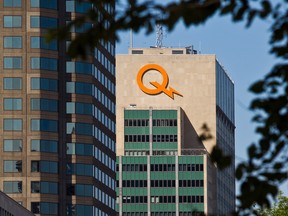Payment comes as reparations for Lac-Robertson dam, built on community’s lands 30 years ago without an agreement or compensation.

Article content
UNAMEN SHIPU — To ease the bitterness of past wrongs and with an eye to future energy agreements with Indigenous communities, Hydro-Québec signed a $32-million agreement with the Innu community of Unamen Shipu Monday as “economic reconciliation” for a dam built on their ancestral territory 30 years ago.
Hydro-Québec chief executive officer Michael Sabia and Quebec Minister Responsible for Relations with the First Nations and the Inuit Ian Lafrenière flew from Montreal to the remote village of 1,200 people on the north shore of the Gulf of St. Lawrence Monday morning to officially ink the Mishta Uashat Lac-Robertson agreement with the Unamen Shipu council.
Advertisement 2
Story continues below
Article content
Article content
Kateri Champagne Jourdain, minster responsible for employment and the Côte-Nord region, also attended.
The signing was followed by a celebratory lunch attended by members of the community, featuring caribou paté and potatoes.
The payment and apology were for damages done by Hydro-Québec when the Lac Robertson dam was built in the 1990s, with no agreement made with the local community, and no compensation ever paid. In November, Sabia travelled to Unamen Shipu to offer an apology on behalf of the corporation.
The $32 million will be paid out over 23 years in annual payments.
“The signing of this agreement with Unamen Shipu is based on two fundamental principles of economic reconciliation,” Sabia said. “First, it’s a step toward recognizing and righting the past. And for the years to come, it will permit the creation of a source of revenues that the community can invest according to its priorities.”
Sabia stressed Monday that the agreement is only about fixing the wrongs of the past and has nothing to do with any future agreements.
The agreement comes months after Hydro-Québec announced it plans to invest $185 million by 2035 to meet the province’s coming energy needs, which are expected to double by 2050. Much of that new power is projected to come through the creation of dams and wind-power generators to be built on Indigenous lands.
Article content
Advertisement 3
Story continues below
Article content
Chief Raymond Bellefleur said a portion of the money will go toward building a residence for older adults in the community, who are often forced to live far away due to a lack of housing. Another part will go to an emergency fund that can be used to transport village residents who need medical attention, or family members accompanying them.
Among the possible new dams envisaged by Hydro-Québec is one on the Little Mécatina River, which is also part of the ancestral territory of Unamen Shipu. Hydro-Québec’s announcement in April 2023 that it was interested was immediately contested by Innu leaders who said it would flood 228 square kilometres of their land. Bellefleur said there would be no agreement unless Hydro-Québec did a proper consultation with the Innu of Unamen Shipu.
“Hydro-Quebec seems to care very little about what the community thinks, and this makes us very angry,” Bellefleur said in September, noting that the Innu had been denouncing a lack of consultation since 2010. He told Radio-Canada his community “would deploy all the means necessary to ensure the project would not go through.”
Advertisement 4
Story continues below
Article content
Bellefleur said he would seek aid from other Innu communities and the Assembly of First Nations of Quebec and Labrador (AFNQL).
“Their territories were pillaged, and it was the Indigenous communities that paid,” AFNQL president Ghislain Picard said in September. “There was no form of payment or compensation that was given or even envisaged. It is time for that to stop.”
Monday’s “economic reconciliation” comes as the Quebec government pledges to form a new kind of partnership with First Nations groups for energy agreements. In its 2035 plan, Hydro-Québec said it planned to invite Indigenous groups to become financial partners in infrastructure projects on their territories, a pledge echoed by Quebec Economy Minister Pierre Fitzgibbon.
In mid-April, Hydro-Québec and the Mohawk Council of Kahnawake signed an accord that will make the Indigenous community a co-owner of a $1.1-billion transmission line exporting electricity to New York City. It will be the first time Hydro-Québec shares ownership of its transmission infrastructure with a third party and a First Nation community.
Advertisement 5
Story continues below
Article content
With the Crown corporation projecting it will run out of energy surpluses by 2027 and will need to build dams and wind farms on Indigenous lands, the partnership is a sign of things to come, Sabia said at the time.
In February, the Innu community of Pessamit signed a preliminary agreement with Quebec and Hydro-Québec as a first step toward forming a partnership in an energy agreement.
Sabia, who served as Canada’s deputy minister of finance before becoming CEO of Hydro-Québec in the summer of 2023, said he has been travelling to the north frequently in his new role.
“I learned in my visits here that this dam was created without any agreement with the local community,” Sabia told the community on Monday. “There is one word for this: unacceptable. And for that I am sorry, and you have our apologies.”
Monday’s agreement, Sabia said, is an effort to recognize the wrongs and create “a better base on which to forge a relationship of respect for the future.”
Recommended from Editorial
Advertisement 6
Story continues below
Article content
Article content


Comments